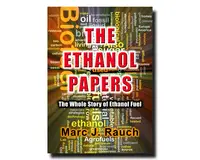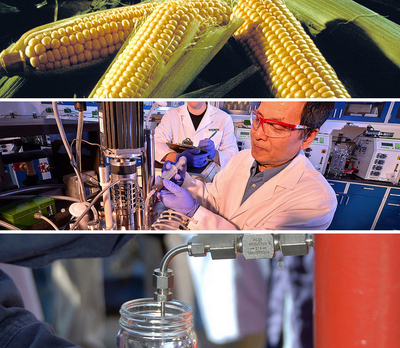Building the Evidence on Corn Ethanol’s Greenhouse Gas Profile
"The last decade was a time of great innovation and productivity improvement"
Originally posted on the U.S. Department of Agriculture website by Jan Lewandrowski, Project Manager, USDA Office of the Chief Economist
Annotations by Marc J. Rauch, Co-Publisher of TheAutoChannel.com
Over the past two decades, the demand for renewable fuels — including corn-based ethanol — has helped drive a strong domestic market for corn, and supported rural America by generating jobs. New research is confirming that corn ethanol also has more greenhouse gas benefits than previously thought.
A study we just published in the journal Biofuels found that the greenhouse gas (GHG) emissions from corn ethanol are about 39 percent lower than gasoline on energy equivalent basis. The study,
titled "The greenhouse
gas benefits of corn ethanol - assessing recent evidence", also found that when ethanol is produced at natural gas-powered refineries, the GHG emissions are even lower—around 43 percent below gasoline.
This study confirms work that we released in 2018 and adds to the mounting evidence of ethanol’s GHG benefits,
which have been often overlooked.
Not just overlooked, but completely ignored and trampled over by the petroleum oil industry and all of their shills.
Unlike estimates of ethanol’s GHG profile from the early 2000’s, which relied on projections of how growing corn for fuel would impact emissions, we now have the benefit of looking back in time to see how the
industry responded to the requirements of the Renewable Fuels Standard (RFS). As it turns out, the data show that the last decade was a time of great innovation and productivity improvement in both corn production and ethanol
refinery technologies. The story of how farmers and ethanol producers responded to the requirements of the RFS is one worth understanding—and this story is now being told in the peer-reviewed literature.
This story is nothing short of "heroic.
Projections of Increased GHG Emissions due to Land-Use Change Didn’t Materialize
Earlier estimates of ethanol’s GHG emissions assumed the increased price of corn (caused by increased demand for corn ethanol) would result in farmers bringing new land into production (otherwise known as land-use change).
Projections warned of an increase in GHG emissions from tilling native grassland, and converting wetlands and forests for corn production. More recent research shows that, while there has been some conversion and reallocation of
land, things did not end up playing out the way these earlier projections anticipated.
The oil industry prayed this would happen and caused most of the irresponsible reports circulated throughout media.
A 2015 study published in the Annual Review of Resource Economics showed that although higher corn prices gave an incentive to farmers to grow more corn, farmers responded with increases in double-cropping and planting in fields that were fallow, and reducing temporary pasture to increase corn production—and far less land use change than originally predicted. In other words, although farmers produced more corn, they relied on improved technology and intensive cropping on existing fields rather than converting new lands into production.
Another study published last year in the American Journal of Agricultural Economics found that between 2003 and 2014, increases in ethanol demand
alone led to a 3 percent increase in corn acreage, and less than one percent increase in total crop acreage in the United States by 2012 compared to 2008. This was a far smaller impact than previously projected.
In fact, corn crop land use for 2018 was lower than 2008.
These studies demonstrate that although there were additional acres brought into corn production as a result of ethanol demand, the land use change impacts weren’t nearly as drastic as we once thought.
Corn crop land use for for the last 14 years (2005-2018) was lower than the 14 year period of 1926-1939.
Better Refining Technology and Land Management Have Also Improved Ethanol’s GHG Balance
But it isn’t just land use change that influences the GHG balance of ethanol. How corn is produced on farms and how refineries operate can also have a large impact on greenhouse gases, from the changes in soil carbon and the emissions associated with growing crops, to the GHG emissions from producing the fuel.
Independent of our study, another recent analysis titled, “Land management change greatly impacts biofuels’ greenhouse gas emissions,” and published in the journal Global Change Biology Bioenergy in 2018 found that when corn farmers adopt practices that increase soil organic carbon, such as using manure and cover crops, the lifecycle GHG emissions for ethanol are about 40 percent lower than gasoline.
Our article in the journal Biofuels also assessed the GHG impacts of improved technologies. These include adopting conservation on corn farms, such as cover crops, no-till, and precision agriculture technology, which can decrease emissions on the farm level. Combined with efficiency improvements in refineries, such as switching to biomass as a process fuel, these improvements could result in a 70 percent lower GHG emission profile for ethanol over gasoline by 2022.
Refinery efficiency improvements can have benefits beyond reducing GHG emissions as well, such as producing co-products like corn oil. Since 2010, ethanol refineries have evolved by adopting more efficient processes to produce more ethanol per bushel of corn. Of course, taking these changes into account further drives down ethanol’s lifecycle GHG emissions.
All this research aside, there are certainly environmental tradeoffs involved in ethanol production. Any form of energy production has social and environmental costs. However, when it comes to GHGs, the evidence demonstrates that corn ethanol is a net positive compared with gasoline—and there is room for continued improvement.
There’s one more point worth mentioning here: incentivizing ethanol through the Renewable Fuels Standard has offset 10 percent of our reliance on fossil fuels in the transportation sector. No matter how you look at it, that’s progress towards a cleaner energy future.
This recent study released by USDA is just the latest authoritative study to show that ethanol fuel production and use is far cleaner, safer, and economically viable than the oil industry has claimed (and prayed for). For more information about these other studies read the following stories:
Biofuels & Greenhouse Gas Emissions: Myths versus Facts
Innovation is Driving Down Greenhouse Gas Emissions from Corn-based Ethanol
Argonne Lowers Land Use Change GHG Emissions For Corn Ethanol
Review and Evaluation of Studies on the Use of E15 in Light-Duty Vehicles
Land-use change and greenhouse gas emissions from corn and cellulosic ethanol
Fuel Ethanol Produced from Midwest U.S. Corn: Help or Hindrance to the Vision of Kyoto?
 |
If you like to know more about ethanol fuel, LOTS MORE, read Marc Rauch's 641-page book "THE ETHANOL PAPERS." It's available online for FREE by CLICKING HERE.



